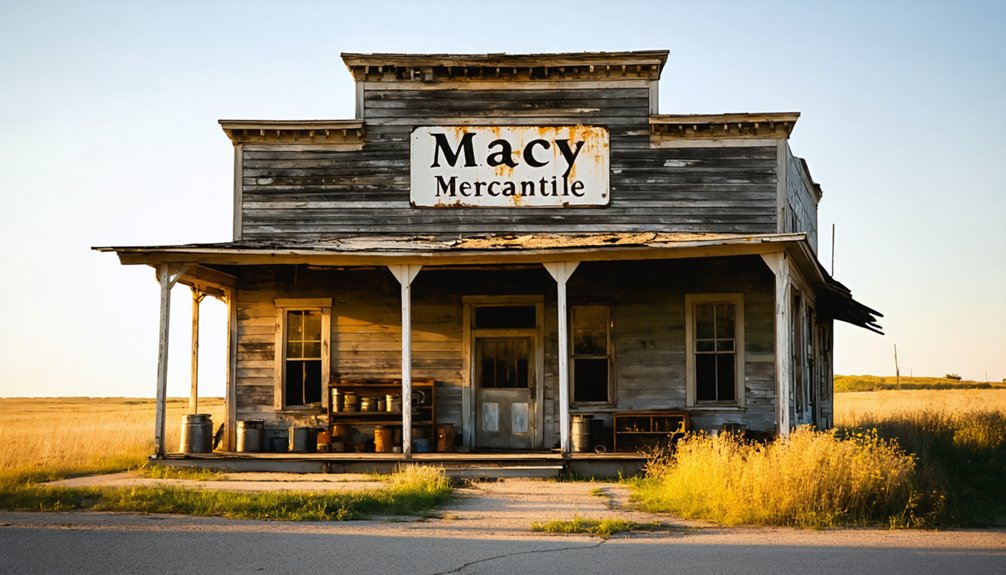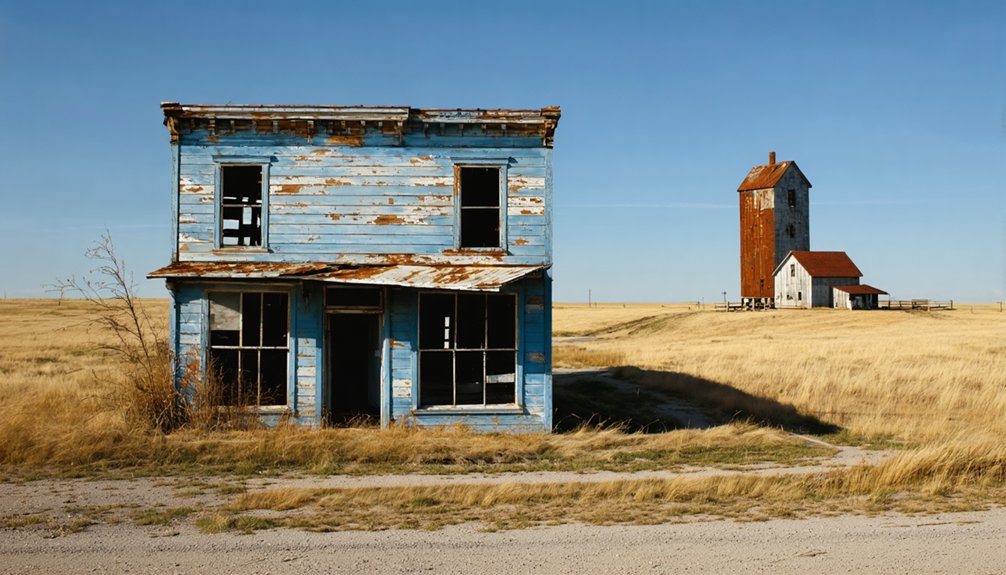You’ll discover the haunting remains of Macy in South Dakota’s Black Hills, where gold fever sparked a bustling mining settlement in 1874. After Custer’s expedition found gold in Castle Creek, over 100 settlers flocked to try their luck at placer mining and later industrial extraction. Today, you can explore the weathered ruins of this authentic ghost town, including an empty motel and abandoned church, while prairie dogs scamper through the foundations that whisper tales of boom-and-bust dreams.
Key Takeaways
- Macy emerged during the 1875 Black Hills gold rush but declined by the 1920s, eventually becoming a ghost town in South Dakota.
- The town’s remaining structures include an empty motel, abandoned church, and scattered residential ruins overtaken by prairie wilderness.
- Prairie dogs now inhabit the weathered buildings, creating an authentic ghost town atmosphere amid the Badlands backdrop.
- The South Dakota State Historical Society maintains extensive documentation of Macy’s history through archives, photographs, and oral histories.
- Preservation groups work with landowners to protect the site, while offering educational programs and ghost town walking tours.
The Birth of a Mining Town
While the Black Hills had already drawn prospectors by the mid-1870s, Macy’s story began when George Armstrong Custer’s expedition first explored Castle Creek valley in 1874.
Government geologists Walter Jenney and Henry Newton discovered gold in the creek’s gravels the following year, drawing early settlers to this promising location. The area saw rapid development as the population quickly grew to over 100 settlers by 1879.
Much like nearby mining camp Mystic, established in 1876, Macy emerged during the Black Hills gold rush era.
Gold Rush Glory Days
You’ll find that Macy’s miners initially focused on placer gold deposits in nearby creeks, using basic panning and sluicing methods to extract loose gold particles from stream sediments.
As operations expanded, you’d see the introduction of more sophisticated mercury amalgamation techniques that helped process the harder rock ores being discovered throughout the region. The discovery originated from Custer’s 1874 expedition which sparked the entire Black Hills gold rush. The rush violated the Treaty of Fort Laramie as thousands of miners illegally flooded into Sioux territory.
The rush for quick riches transformed Macy’s mining operations from simple creek-side prospecting to industrial-scale extraction, though the town never achieved the sustained success of neighboring communities like Lead with its massive Homestake Mine.
Mining Technology Advances
During the glory days of Macy’s gold mining era, technological advances revolutionized how miners extracted precious metals from the earth. The technological evolution brought notable changes, as operations shifted from basic panning methods to more sophisticated mining innovations. By the late 1800s, the introduction of chemical treatment methods dramatically improved gold extraction efficiency. Basic prospecting tools like sluice boxes helped establish early mining operations in the area.
You’d have seen the transformation from hand drills and black powder to powerful steam-driven machinery and dynamite blasting.
- Local miners embraced the Blake Crusher when it arrived in 1861, notably improving their ability to process hard rock ore.
- The introduction of stamp mills throughout the region allowed for efficient crushing of gold-bearing quartz.
- Steam-powered pumps and mechanical drills replaced manual labor, enabling deeper exploration of Macy’s rich mineral deposits.
These advancements helped Macy’s mining operations reach new depths and extract more gold, though they also brought challenges like increased silicosis risks among workers.
Rush for Quick Riches
As news of gold’s discovery in the Black Hills spread in 1874, prospectors flooded into Macy and the surrounding region, ignoring established treaties with the Sioux Nation. You’d have found thousands of fortune seekers battling harsh conditions, their gold fever driving them to stake claims along every promising creek and gulch.
Life wasn’t easy for these early prospectors. While some struck it rich panning placer gold from streambeds, most faced intimidating prospecting challenges. Initial prospectors found gold at French Creek, but the amounts were minimal and disappointing.
The real prosperity came after Fred and Moses Manuel’s discovery of the Homestake Mine in 1876, which shifted focus from simple panning to hard rock mining. You would’ve seen boomtowns spring up overnight, with miners’ tents dotting the landscape. The mine became a legendary producer, generating 10% of world gold during its 125-year operation.
Though many dreamed of striking it rich like the Homestake discoverers, few found lasting fortune in those early rush days.
Railroad’s Arrival and Impact
While southeastern Dakota Territory had already established rail connections through Yankton by 1880, the crucial surveys for a Scotland Junction to Mitchell line in 1886 transformed the region’s development patterns. Like many other South Dakota settlements, Macy followed a standard T-shaped layout design.
The railroad expansion brought unprecedented economic transformation to towns like Macy, reshaping the landscape of opportunities and commerce. You’ll find the Milwaukee Railway’s influence stretched far beyond mere tracks, determining which communities would thrive and which would fade into obscurity. Local speculators aggressively purchased land parcels in anticipation of future rail routes.
- Railroad depots became essential community hubs, centralizing mail service, passenger travel, and freight shipping.
- Grain elevators and livestock shipping facilities sprung up along the tracks, connecting local farmers to distant markets like Chicago.
- Entire communities relocated to capitalize on rail proximity, leading to both rapid growth and ghost towns depending on final route selections.
Daily Life in Early Macy
From their modest beginnings in the late 1870s, Macy’s pioneering residents built a tight-knit farming community centered around the railroad’s promise of prosperity.
Daily routines revolved around agricultural work, with farmers tending to wheat fields and livestock while merchants operated essential services like general stores and blacksmith shops. You’d have found the one-room schoolhouse serving as both an educational center and a hub for social gatherings, where families came together for town meetings and seasonal celebrations.
Life wasn’t easy in those early wooden homes with basic amenities, but community bonds grew strong through shared experiences.
Church picnics, barn dances, and Fourth of July festivities provided welcome breaks from labor, while fraternal organizations offered mutual support. Local newspapers kept everyone connected to regional happenings and strengthened the town’s shared identity.
The Slow Descent Into Abandonment

Despite Macy’s early promise as a railroad hub, the town’s decline began subtly in the 1920s when larger regional centers started drawing away business and residents.
As economic stagnation took hold, you’d have witnessed the gradual exodus of families seeking opportunities elsewhere. The town’s isolation from major highways and its dependence on agriculture made it particularly vulnerable to the region’s shifting economic landscape.
The path to abandonment was marked by:
- A devastating drought in the 1930s that crippled local farming operations
- The closure of essential services, including the general store and post office
- A sharp population decline as younger generations chose urban opportunities over rural life
The absence of industry diversification and limited access to modern amenities ultimately sealed Macy’s fate, transforming it from a bustling community into a ghost town.
What Remains Today
Today in Macy, a handful of original structures stand as silent sentinels to the town’s forgotten past.
You’ll find an empty motel building, a church without a congregation, and scattered residential ruins – their roofs often missing or damaged. The current condition reflects years of abandonment, with nature slowly reclaiming the site.
As you explore the grounds, you’ll notice the surrounding prairie has overtaken former building sites, leaving only scattered foundations and footings.
The badlands backdrop adds to the desolate atmosphere, while prairie dogs have made homes among the remaining structures.
While you’re free to walk through this piece of history, there’s no formal tourism infrastructure.
What you’ll discover is an authentic ghost town experience, complete with weathered buildings, old signage, and the unmistakable quiet of a place time forgot.
Preserving Macy’s Legacy

If you’re interested in Macy’s legacy, you’ll find extensive documentation efforts by the South Dakota State Historical Society that chronicle the town’s role in Black Hills settlement patterns through photographs, maps, and written records.
Local preservation groups work closely with private landowners to protect remaining structures while balancing public access and educational opportunities.
The community’s commitment to safeguarding Macy’s heritage includes regular site monitoring, stabilization projects, and partnerships with regional historical organizations to share its story with future generations.
Historic Documentation Efforts
Through diligent efforts by the South Dakota State Historical Society, thorough documentation of Macy’s history has been meticulously preserved in state archives, including essential correspondence, research notes, and official records.
The archival research combines post office records, census data, and county registers to verify the town’s existence and development. You’ll find that oral histories from elderly residents have added invaluable personal perspectives to the documented timeline.
- Historical maps and USGS surveys pinpoint Macy’s exact location and structural remains
- Scholarly publications examine the socioeconomic factors behind Macy’s rise and decline
- South Dakota Public Broadcasting has produced documentaries featuring interviews with historians and ghost town experts about Macy’s significance
Community Preservation Projects
Local community members have rallied together to preserve Macy’s historic legacy with remarkable dedication and resourcefulness. Through volunteer initiatives like organized clean-ups, path maintenance, and storytelling events, you’ll find a tight-knit network of preservationists keeping the town’s history alive.
Community engagement thrives through annual ghost town walks, educational programming, and partnerships with state organizations. You can participate in these preservation efforts through the Historical Society’s events, where local vendors and artists showcase regional culture while raising funds for restoration.
University students and faculty contribute research expertise, while descendants of former residents share oral histories. Despite challenges with private land access and limited resources, the community’s collaborative spirit guarantees Macy’s heritage endures for future generations to explore and appreciate.
Frequently Asked Questions
Are There Any Documented Paranormal Activities or Ghost Sightings in Macy?
You won’t find documented ghost encounters or spectral sightings in this location. Unlike other Black Hills ghost towns, there aren’t any verified paranormal reports from historical societies or local records.
What Happened to the Original Residents After They Left Macy?
You’ll find no specific records tracking Macy residents’ post departure paths, though like other Black Hills ghost town communities, they likely scattered to nearby economic hubs seeking fresh opportunities.
Was Any Significant Native American History Recorded in the Macy Area?
While Native tribes were present in South Dakota, you won’t find historical treaties or significant recorded Native American activity specific to Macy’s location. The area lacks documented Indigenous settlement evidence.
Were There Any Famous Outlaws or Notable Crimes in Macy?
You won’t find records of famous outlaws or notable crimes specific to Macy. While nearby Black Hills towns like Deadwood saw significant criminal activity, Macy remained relatively quiet regarding lawlessness.
Did Macy Have Any Unique Local Customs or Celebrations?
Like many fleeting Black Hills settlements, you won’t find records of unique Macy traditions or festivals. Its brief existence from 1893-1907 meant customs rarely took root beyond basic mining town gatherings.
References
- https://www.powderhouselodge.com/black-hills-attractions/fun-attractions/ghost-towns-of-western-south-dakota/
- https://www.youtube.com/watch?v=Glucs_Rq8Xs
- https://www.sdpb.org/rural-life-and-history/2023-08-21/some-black-hills-ghost-towns-and-their-origins
- https://www.sdhspress.com/journal/south-dakota-history-2-2/some-black-hills-ghost-towns-and-their-origins/vol-02-no-2-some-black-hills-ghost-towns-and-their-origins.pdf
- https://www.youtube.com/watch?v=_0WNYsFLSLA
- https://www.historynet.com/ghost-towns-mystic-south-dakota/
- https://en.wikipedia.org/wiki/List_of_ghost_towns_in_South_Dakota
- https://ruralresurrection.com/ghost-towns-mystic-south-dakota/
- https://icatchshadows.com/okaton-and-cottonwood-a-photographic-visit-to-two-south-dakota-ghost-towns/
- https://www.legendsofamerica.com/mystic-south-dakota/



